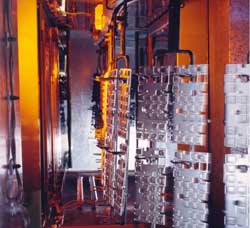Paint on Plastic Dries More Quickly with Infrared Emitters

Medium wave infrared emitters from Heraeus Noblelight dry keypads much faster than a hot air oven. This increases quality and saves energy. Copyright Heraeus Noblelight 2007
Conventionally, these lacquers and coatings are dried or cured by means of hot air. Increasingly, the market requires faster production speeds, which, in many cases, can be achieved by means of infrared drying. A British manufacturer of key boards and keypads is drying its protective lacquer coatings in less than four minutes using infrared, compared with the previous 20minutes required by a hot air oven.
Heraeus Noblelight will be showing emitters for lacquer drying on stand 3541, Hall 3, at PaintExpo in Karlsruhe.
Kestrel Injection Moulders in Great Britain produces keyboards and keypads for cars or for use in electronic equipment, computers or white goods. These pads are injection moulded plastic products and need to be printed and coated with a protective clear lacquer. Previously, the components had to be dried for around 20 minutes in a hot air oven. During this extended period, dust could settle on the product to adversely affect the quality.
An infrared oven from Heraeus Noblelight is now drying and curing the coatings on the keypads in less than 20% of the time required by the convection ovens.
With its 1.5m length and 1m height, the infrared oven fitted easily into the available space. It consists of two modules, each of 3 kW output and is fitted with medium wave infrared emitters, which in pre-installation trials had proved themselves as a successful and faster alternative to hot air.
Currently, the new ovens handle two different types of keypads. One type is coated with a water-based lacquer after manufacture, is pre-dried, printed and then finished with a clear protective lacquer. Other keypads do not require a pre-coating and can be immediately printed and coated with the protective lacquer.
Since the installation of the infrared ovens, the rejection rates have been significantly reduced. Naturally, this enormously reduces the time in which dust can fall on the keypad surfaces. In addition, the infrared system has also proved itself to be extremely energy-saving, as, in contrast to the convection ovens, it needs to be switched on only when heating is required.
Heraeus Noblelight offers a comprehensive range of infrared emitters to heat plastics, lacquers or coatings rapidly and efficiently. Infrared ovens are so compact that they can be easily retrofitted into existing production systems and layouts. This saves space, time and cost.
Heraeus Noblelight GmbH with its headquarters in Hanau and with subsidiaries in the USA, Great Britain, France, China, Australia and Puerto Rico, is one of the technology- and market-leaders in the production of specialist light sources. In 2006, Heraeus Noblelight had an annual turnover of 88 Million € and employed 651 people worldwide. The organisation develops, manufactures and markets infrared and ultraviolet emitters for applications in industrial manufacture, environmental protection, medicine and cosmetics, research, development and analytical laboratories.
Heraeus, the precious metals and technology group headquartered in Hanau, Germany, is a global, private company in the business segments of precious metals, sensors, dental and medical products, quartz glass and specialty lighting sources. With revenues of more than EUR 10 billion and more than 11,000 employees in over 100 companies, Heraeus has stood out for more than 155 years as one of the world’s leading companies involved in precious metals and materials technology.
Further Information:
Readers:
Heraeus Noblelight GmbH
Reinhard-Heraeus-Ring 7
D-63801 Kleinostheim
phone +49 6181/35-8545, fax +49 6181/35-16 8545
E-Mail hng-infrared@heraeus.com
Press:
Dr. Marie-Luise Bopp
Heraeus Noblelight GmbH,
phone +49 6181/35-8547, fax +49 6181/35-16 8547
E-Mail marie-luise.bopp@heraeus.com
Media Contact
More Information:
http://www.heraeus-noblelight.comAll latest news from the category: Trade Fair News
Newest articles

Security vulnerability in browser interface
… allows computer access via graphics card. Researchers at Graz University of Technology were successful with three different side-channel attacks on graphics cards via the WebGPU browser interface. The attacks…

A closer look at mechanochemistry
Ferdi Schüth and his team at the Max Planck Institut für Kohlenforschung in Mülheim/Germany have been studying the phenomena of mechanochemistry for several years. But what actually happens at the…

Severe Vulnerabilities Discovered in Software to Protect Internet Routing
A research team from the National Research Center for Applied Cybersecurity ATHENE led by Prof. Dr. Haya Schulmann has uncovered 18 vulnerabilities in crucial software components of Resource Public Key…





















